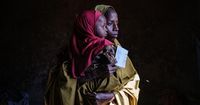Women carrying frail children line up in the early morning heat outside a shuttered clinic in Maiduguri, northeastern Nigeria. They wait for hours, clutching the hope of receiving a small, red packet—a ready-to-use therapeutic food (RUTF) that could save their children from starvation. But as the sun rises, many will leave empty-handed. The shelves are bare, and the doors to many clinics are now closed, casualties of a sweeping freeze on U.S. foreign aid that has sent shockwaves through global humanitarian efforts.
This crisis has unfolded rapidly since January 20, 2025, when President Donald Trump, on the day of his second inauguration, ordered a 90-day pause on all foreign aid. According to The New York Times, the abrupt halt has led to the closure of hundreds of clinics across Africa, Asia, and the Middle East—many of which were the last lifeline for severely malnourished children. The effects have been especially dire in places like Nigeria, where 150 World Food Programme clinics serving more than 300,000 children under two shut down at the end of July. In Bauchi state alone, Helen Keller International was forced to stop treating malnutrition in 16 of its 17 centers, leaving over 17,000 children without care.
The United States Agency for International Development (USAID) previously funded about half the world’s supply of RUTF, a high-calorie blend of peanuts, sugar, milk powder, and vital nutrients. For less than 30 cents a packet—or under $45 for a full six-week course—these sachets can nurse a child back from the brink. But after the aid freeze, millions of dollars’ worth of these lifesaving packets now sit stranded in warehouses, ports, and shuttered clinics. “We have seen the mortality rates in the hospitals increasing by the day,” said Aliyu Mohammed Jabo, Helen Keller International’s director for Nigeria. “This is the ugly situation that we are facing because of this funding cut.”
On August 13, 2025, a federal appeals court delivered a legal blow to those hoping for a swift restoration of aid. The court overturned a previous ban that required the State Department to continue making foreign aid payments, siding with President Trump’s administration. The ruling, as reported by The Washington Post, emphasized that only the U.S. House of Representatives—not nonprofit groups—has the authority to challenge the president’s actions in halting foreign aid payments. District Judge Karen Henderson, writing for the majority, stated that the nonprofits “have no cause of action to substantiate their claims” and do not qualify for an injunction. The court did not address whether the freeze itself violates the Constitution by curtailing congressional authority, leaving that question unresolved.
The decision has ignited a fierce debate over the separation of powers and executive authority. District Judge Florence Pan, dissenting, warned, “The court’s acquiescence to illegal executive behavior undermines the carefully crafted system of checks and balances that serve as the greatest safeguard against tyranny—the accumulation of excessive power in one branch of government.” A spokesperson for the White House Office of Management and Budget countered, arguing that the ruling would prevent “radical left-wing financial groups from maliciously preventing the President from spending responsibly and administering foreign assistance lawfully in accordance with his ‘America First’ policy.”
For those on the ground, the legal wrangling feels painfully abstract compared to the immediate realities. In countries like Chad, Mali, Niger, Syria, Burkina Faso, Kenya, South Sudan, Afghanistan, and Nepal, clinics have closed or are running dangerously low on supplies. In South Sudan, the International Rescue Committee estimates that 62 static sites and nine mobile clinics may close by September if funding isn’t restored. In Nepal, about half the provinces have already run out of RUTF, threatening the lives of 200,000 malnourished children, including 25,000 at risk of death.
Despite the mounting evidence, U.S. Secretary of State Marco Rubio has repeatedly denied that any children have died as a result of the aid cuts and the dismantling of USAID, calling such reports “false” and “fake.” Yet, organizations like Doctors Without Borders and Action Against Hunger have documented child deaths linked to malnutrition. “No one’s counting these children,” said Jeanette Bailey, director of Nutrition for the International Rescue Committee. “With pretty strong certainty, we know children are dying. But we don’t know how many.” A global study has estimated that more than 160,000 children might die each year if funding is not restored.
The stop-and-start nature of U.S. government support has also thrown the once intricate aid delivery network into chaos. According to The New York Times, American farmers who supply peanuts, milk powder, and soy to RUTF manufacturers like Edesia and Mana are now left in limbo. Edesia’s CEO, Navyn Salem, described the situation as “a very stressful waiting game,” noting that farmers “can only hold on for so long.” Edesia recently shipped 122,000 boxes to Sudan and still has 185,000 more in its warehouses, while Mana has 400,000 boxes awaiting shipment.
Last week, the State Department authorized a $93 million grant to UNICEF—its first large grant for 2025—to supply RUTF to 12 African countries and Haiti. While this is a lifeline, it is less than half the typical annual U.S. spending on such programs. The grant will provide enough packets for about 800,000 children through June 2026 and fund the distribution of more than 1,200 metric tons of stalled supplies, enough for 87,000 children. However, UNICEF officials warn that it will take two to three months for products to be delivered, as orders must be placed, manufactured, and shipped—often through treacherous routes and rough roads. “It really comes down to the children who do not have time to waste,” said Navyn Salem.
Meanwhile, some governments and organizations are scrambling to fill the gap. Countries like Nigeria, Kenya, and Burkina Faso are boosting local production of RUTF, and the Child Nutrition Fund, started by UNICEF and the British government, offers a 1:1 match to encourage national investment. Philanthropy is also playing a role: Mana received a $20 million gift from a British philanthropist, and Edesia has raised $2 million in private funding to ship boxes to the neediest sites.
Yet, the scale of the crisis is daunting. Acute malnutrition, or wasting, affects about 43 million children worldwide, and even before the aid freeze, many went untreated. In 2023, RUTF reached 9.3 million children, but the need is far greater. The first 1,000 days of life are critical for brain development, and severely malnourished children are up to 11 times as likely to die as healthy peers. Severe wasting accounts for as many as one in five deaths of children under five globally.
For mothers like Maryam Mohamed in Maiduguri, the policy debates and legal decisions in Washington feel impossibly distant. She has walked miles with her three severely malnourished boys, searching for help as clinic after clinic shuts down. “I wish they will have a change of decision,” she said of the Trump administration. “They should please try to help by not stopping the supply.”
As the world’s attention shifts from one crisis to the next, the fate of millions of children hangs in the balance, waiting for the machinery of aid—and the political will behind it—to move faster than hunger itself.




